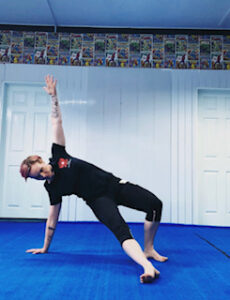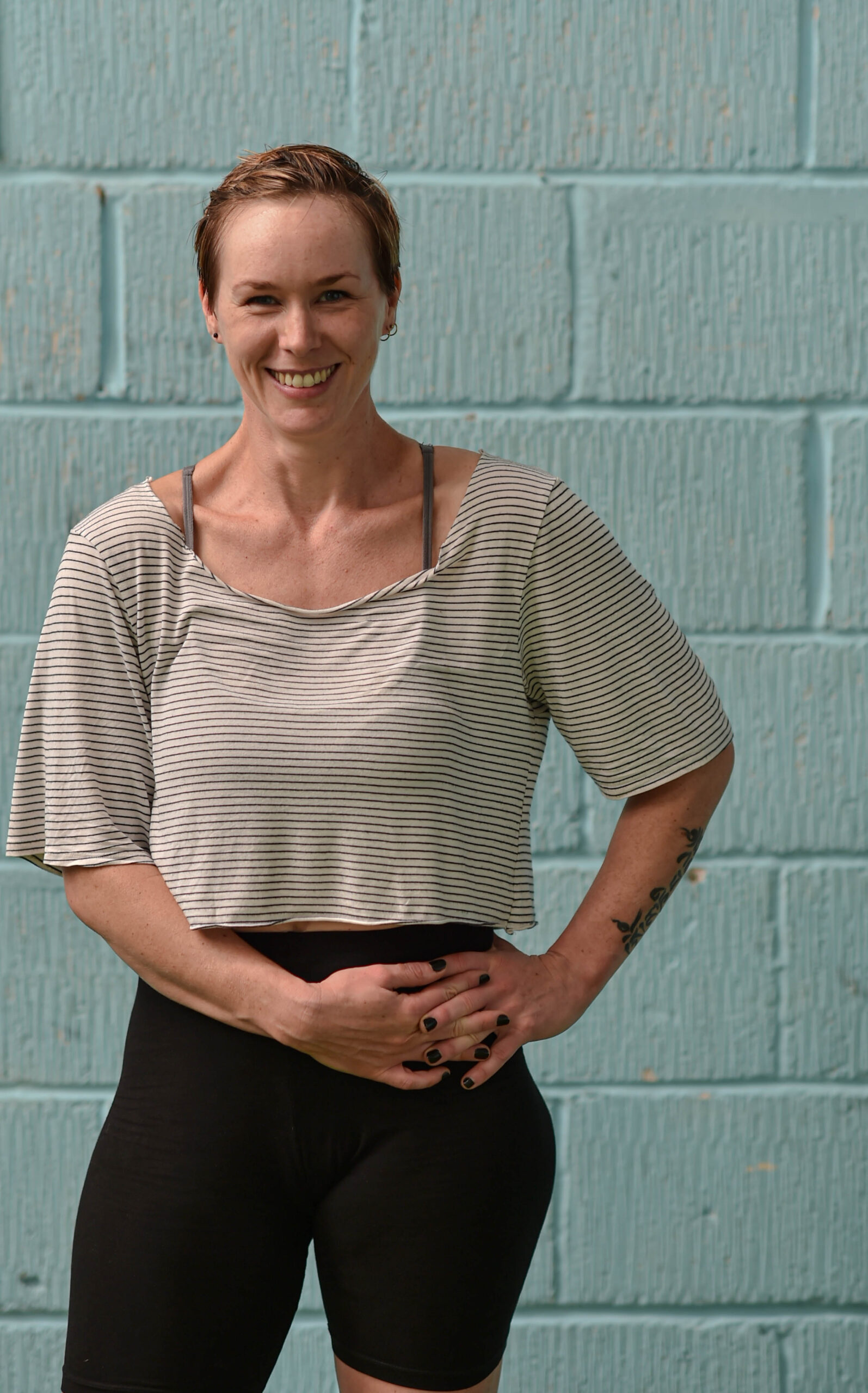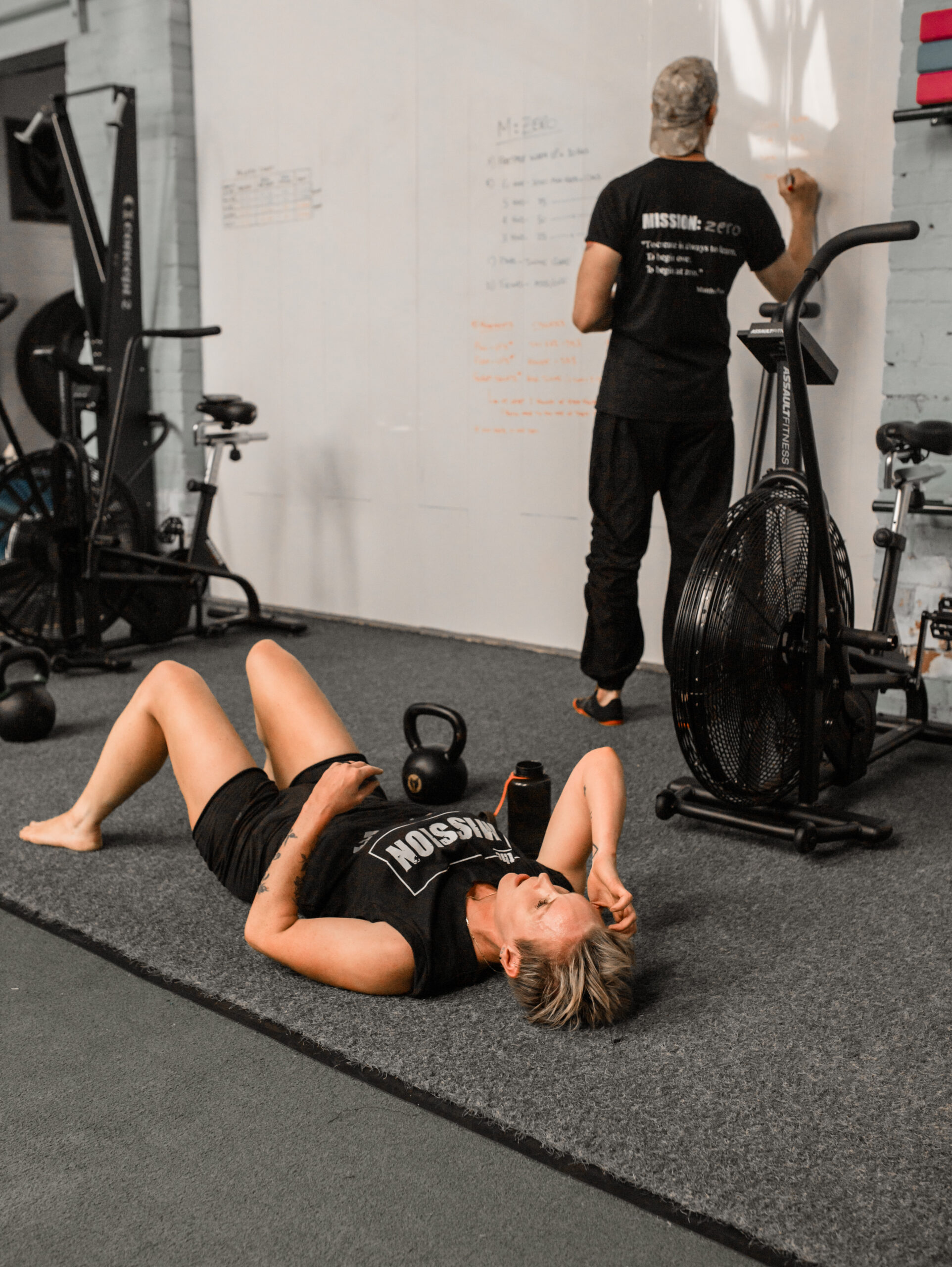The Big Six Kettlebell Exercises –
- What are they?
- Why have you chosen those ones?
- What will they do for my body?
The magic, the benefits of using comes from using the right kettlebell weight, with the right techniques and the right movements – and there are 6 movements unique to kettlebell training that give your whole body a tremendous input and cause the changes in your body that you’re hoping for.
A body that moves well, feels good to live in, has enough muscle to normalise appetite signals and help maintain blood sugar levels, and makes you feel good about yourself.
This comes from moving heavy enough loads and doing purposeful cardio.
And the great thing about the kettlebell big six, is that the bells don’t even need to be mega heavy to have the effect of moving heavy loads because they become heavier when they are in motion (see: physics), so the harder you move them, the heavier they are, the more cardio you’re doing at the same time as lifting weights, thus the stronger and fitter and more useful a body you build.
So what are our Big Six?
- Swing
- Clean
- Press
- Squat
- TGU
- Snatch
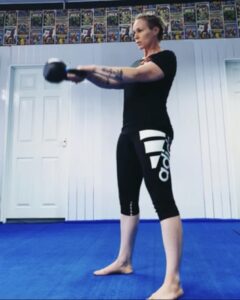 Swings build a well-balanced, athletic physique, tapping into deep postural muscles with a focus on glutes, legs and core.
Swings build a well-balanced, athletic physique, tapping into deep postural muscles with a focus on glutes, legs and core.
They are a potent way to build full body muscle tone and to do the kind of cardio that creates changes in your body at a metabolic level.
Once a body has mastered kettlebell swings, they level up. They have no reason to ever not become, and stay, as fit, strong and athletic as you want them to be. If you can do swings, you can make your body stronger and fitter just by doing more swings, more often. Gym life will be much simpler!
Swings focus on your posterior chain: the muscles down the whole of the back of your body – legs, glutes, back, deep core. These are the muscles that, without strength training, spend most of your life getting weaker (see: slightly hunched posture and generic bad back!)
Kettlebell swings are also the movement that all other kettlebell skills are built upon, so you’ve done most of the groundwork for the other 5 skills when you’ve mastered these, yet they are safe enough to be mastered and trained from the youngest to the oldest trainees.
If there’s only one exercise you learn, and get really strong at, swings should be it.
I guarantee that once your body starts to feel the way that heavy swings make a body feel, you’ll be asking me for more.
Bonuses:
- A great goal for swings is to work up to 16kg and upwards. The sky (or your kettlebell collection) is the limit with what weight to use for swings, you can’t go too heavy for swings; your body is essentially designed to be able to shift heavy loads with this movement.
- To make a light weight heavier, we can switch to single arm swings
- My favourite way to do swings is EMOM – Every Minute On the Minute. You set a timer to beep every minute (you can get apps for this, called interval timers), you do 10 swings when it beeps and rest the remainder of the minute.
- Go for at least 5 minutes, to however long you’ve got. 100-300 swings is a potent amount of swings during a workout to feel the difference in your body.
- (For a more intense workout, do your swings every 30 seconds instead of every minute)
Cleans are one of my favourite core movements, although it might not look like the kind of exercise that you’d think targets your core. Let me tell you why it does, though.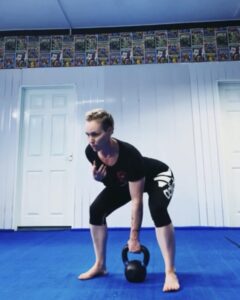
Think of your core as working in an X shape made of string, hips to opposite shoulders.
The tighter you can pull the X shape strings, the stronger, harder, more resilient, and more usefully your core will function. I don’t just mean abs here; I mean all the deep layers of your core structure will be held in a more tightly knitted system that you have control over.
This is where kettlebell cleans come in.
By loading the weight onto one side of your body, using those posterior chain muscles we talked about with kettlebell swings, from a standing start position below your hips, and dynamically powering it up past your hips to sit at shoulder level, you’ll need to knit this X shape together, and hold it together, as you move.
All this, in addition to using all of the same muscles and providing all of the same training effects that kettlebell swings offer.
In conclusion, I think you’ll agree, you need to be doing cleans!
Bonuses:
- These are an excellent movement to do to learn and maintain safe pelvic floor loading – that X shape of your core is linked to strong pelvic floor coordination. Just by practising this movement, you’re asking your pelvic floor to join the game, without having to remember to squeeze it at every set of traffic lights 😉
- Cleans are a way to get the bell onto your body, so that your body is carrying a load. You can either get a great cardio workout by doing the movement of cleans for repetitions or time, OR by doing cleans and then holding the bell in position on your shoulder so that your body has to adapt and build a hard little layer of muscle armour under your skin.
- You can either do cleans from a dead start between your feet, or you can swing them into a clean. I’ll teach you this one inside School Of Bells.
- Despite looking quite simple, these are probably one of the hardest kettlebell skills to get right. Repetition and understanding are key here – keep asking your teacher for assistance and keep practicing.
The following two exercises you CAN do with other tools – dumbbells, barbells, but there’s something unique about using a kettlebell for these two movements that creates outcomes that you can’t just get with other tools.
You’ve heard of a bench press, right? Well, a kettlebell press is the more talented, useful and effective big sister to the bench press. This movement, taking a kettlebell from a clean, to a straight arm overhead position, is the ultimate expression of what your body is capable of.
It’s the ultimate achievement over the bell; the biggest journey your body can take the bell from the floor. It’s essentially, a victory position. It’s the fist punching the air when you’ve won.
There is zero momentum; it’s all you moving that weight. It’s the ultimate posture fixer – holding the weight straight overhead, making your body a straight line. Those muscles in the side of your waist (your obliques) have to work extra hard to maintain your upright position so that you don’t lean over.
Done correctly, it’s also an extremely effective way to strengthen your pelvic floor, because you have to create pressure in your core and then progressively push against it to lift the bell.
Obviously, being an upper body biased movement, you’re developing the muscles of your arms and shoulders – and, by the way, they’re the best way I know to harden your triceps.
If you’re doing presses right, you’re rooting your lower body (you should feel these in your legs and glutes) and working the whole of your body to get that bell moving. If you’re doing swings (an explosive lower body pull), you should also be doing presses (a slow, upper body push) so that you’re getting the best of both types of movement. But, there’s more….
Bonuses:
- You need to clean the bell first to get it here (see last week’s email), and the better your clean, the better your press will be. It acts like a spring load on your body, and for a couple of seconds after a strong clean, you have a bank of residual energy from which to power the bell up.
- Now, this movement is notoriously one of the hardest to build strength in. Don’t let that put you off though; what that means is that this is a movement to use in two different ways. You can follow a programme to make you stronger (to press a heavier bell) and then follow a programme to maintain that new weight you can press. For a while, you’ll keep getting stronger. After that, you’ll just stay strong. Which is ultimately, The Point 🙂
- Keep your elbow pointing at the floor, not poking out to the side of the room for the whole movement. Check it in a mirror.
- Ok, we’re going to get hippy here. But 9/10 if I say to someone struggling halfway up “come on you’ve already got this!”, the bell goes up. This is a movement where visualisation is crucial. See the bell going up.
- If they get easy, and you don’t have a heavier bell, kneel down and do them. Two knees, half kneeling, or even seated to make these harder.
We all know squats develop the muscles in your lower body, and you’ve no doubt got an image of someone doing squats with a barbell on their back as the Epitome of Squat Strength, but kettlebell squats are unique in their challenge and what they do for you.
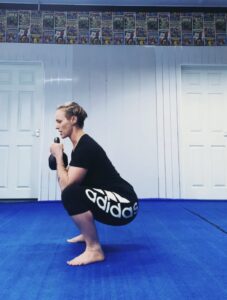 Here’s a surprising fact: someone who can squat 32kg with a barbell on their back (a relatively light load for that movement), who’s never touched a kettlebell before, is highly unlikely to be able to do a simple goblet squat with the same weight kettlebell (what I’m doing in the picture above)
Here’s a surprising fact: someone who can squat 32kg with a barbell on their back (a relatively light load for that movement), who’s never touched a kettlebell before, is highly unlikely to be able to do a simple goblet squat with the same weight kettlebell (what I’m doing in the picture above)
The difference is in the way the kettlebell is loaded on to your body: you have to use a phenomenal amount of leg, core, upper body strength, and coordination to load a goblet squat to 32kg.
In turn, your leg, core and upper body will become more supple and strong. You’ll access areas of your hips and pelvis that had become stiff and unreachable. You’ll strengthen your feet – I know, this sounds wild, but if you feel like you suffer from flat feet a goblet squat is your friend.
And, of course, you’ll develop the muscles in your legs and bum.
Luckily for us, despite it being humbling for gym-goers who squat with a barbell on their backs, this is THE most simple squat to learn and do. It’s the basic squat. It’s what I teach beginners in their first session.
Imagine; such a simple movement will have such a profound impact on the strength and health of your body.
Now that you know this, I bet you’re going to be adding squats to your training pretty damn sharpish.
Bonuses:
- Similar to a press, these are a slow and controlled lift. In this way, they use the same pressure system to safely load and train your core and pelvic floor.
- There are two ways you can use a kettlebell to squat; a goblet squat or a rack squat (single or double bell), done with the right cues and technique, both ways are particularly brilliant for vastly improving your flexibility and have an almost immediate fix on your posture whilst you do them, within a few days of training them.
- Squats are also one of my favourite methods of cardio – not only do I love feeling my legs work hard, I get to spike my heart rate within mere seconds! Try 60 seconds of squats followed by 60 seconds of rest and repeat 5 times. BUT – don’t rush your squats and don’t use momentum; shoot for slow controlled squats where you keep moving for the whole time.
- For strength, cardio and flexibility you’ll do these slightly differently. Strength – higher weight, lower repetitions, cardio – medium weight, and continued movement for a set work and rest times, for flexibility – hold at the bottom and chill.
Next up, Turkish Get-Ups and Snatches. A yin and yang combination that, when mastered, will probably change your life. I mean, I don’t think I exaggerate when I say that but you tell me when you’ve learnt them 😉
These two movements seem like the most complex on the surface, and they aren’t not complex but they can be included in even beginner practices in their broken down forms and you’ll benefit from them immediately.
Why, though, Shell? Why? Tell me about these two magical, sometimes elusive to master, impressive-on-Instagram movements.
Let’s go:
I have three words for you: time. under. tension.
Why do we care about this?
Because a coal turns into a diamond under pressure.
You’re loading your body with a kettlebell for the whole of the ca. 60 seconds or more that it takes to complete a TGU, the weight doesn’t really matter for this to be honest, you just need something up there to hold your attention, then you’re tightly holding your body, controlling and moving it around under a totally straight arm (hello, triceps, our old friends)
This taps into and increases your deep, dense muscle structures, provides all-over muscle tone literally make your bones harder. Bones are totally not sexy, I know, but neither are hip replacements.
There is no other exercise that activates your core to the level that a TGU activates your core. It was the only exercise tested (out of 52 exercises) in experiment by Bret Contreras, to show 100% peak activation in all four core muscles tested by EMG (rectus abdominus, internal oblique, external oblique and erector spinae) to show 100% peak activation in all four core muscles tested by EMG (abs, internal and external obliques and spinal erectors).
As women, we have an open pelvis structure. TGUs put controllable, variable pressure on your pelvic floor and offer it the opportunity to reclaim or just reinforce the coordination of your breathing and pelvic floor.
Nothing else that forces your body to reclaim the coordination you had as a child in quite the same way. You’re using both halves of your body, doing different things at the same time with them (brains LOVE this), and pushing yourself down to get off the floor. This is how you learned to roll, crawl and walk as a baby; coordinating both sides of your body, bracing your core against the floor and pushing up.
And this is the kind of thing we lose as we get older. Imagine how strong you’d be now if you’d continued getting up and down off the floor holding something heavy overhead?
I think you should start now 😉
Bonuses:
- If your leg pops up on the roll-up, you’re probably not rolling, you’re probably trying to do a sit-up with a weight in one arm overhead. Un-fun. Think of this; you’re taking your overhead arm across the centre line of your body and ending up with your shoulders facing the opposite direction to the overhead arm.
- One TGU should take around 60 seconds.
- If you’re finding the coordination hard, start from standing and work your way down (i.e. a Turkish Get-Down) then immediately back up again. This helps some people with “getting” the pattern.
- If you’re skilled at and up for a new challenge with Get-Ups, this article gives some really interesting examples to follow a rabbit hole into, I particularly like the Czech Get-Up* for its links to the way we’re wired to move as babies.
- TGUs are one of my three essential exercises, along with swings and pull-ups. You can do them as a warm-up, for endurance (do multiple reps on the same side), you can add presses to the movement at different points, you can go heavy (make sure you have a spotter!) and they pair really well with an explosive movement like a swing, or snatch. Speaking of which…
- *My friend who teaches this can be found on Instagram under @mobility_czech
And here we are.
Kettlebell snatches. Known as the tsar of kettlebell lifts. I’m going to call them the mother of kettlebell lifts though for obvious reasons.
A kettlebell snatch is the most technically challenging lift, not least because of how fast it requires you to move under load. You’re taking the bell from the floor, to locked out overhead in a press position, as fast and in the shortest line as possible.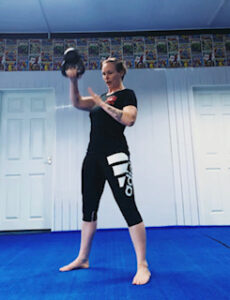
With coordination.
And with a weight.
It’s an explosion from your body. It’s a rocket being launched vertically from your hips.
As such, requires a LOT from you.
This, like swings, has an extreme metabolic effect. You know how HIIT is fashionable? This gets it DONE. In minutes. And builds muscle at the same time.
Something as hard as a snatch can’t NOT create substantial health and fitness changes to your body.
The most feared and revered part of the kettlebell instructor certification is the snatch test (lasting 5 minutes, consisting of 100 snatches with a weight relative to your bodyweight. It’s a once-a-year kind of test. Or sometimes “once is enough” kind of test!)
A kettlebell snatch is the ultimate amplifier of your fitness, metabolism, strength, coordination and power.
They’re the goal, I’d say.
They’re what each exercise I’ve listed up until now is working towards; distilled into one movement; the ability to power your hips like a swing, the ability to power upwards like a clean, the mobility and core strength of a squat, the overhead strength of a press and the control and coordination of a TGU.
See you when you get here 😉
Bonuses:
- High pulls are a perfect way to start working into this movement and getting the bell close to your body and floating high. We learn more about high pulls in School of Bells.
- Train smart with snatches. They don’t allow you to do many of them in a training session before fatigue and the learning curve give way to sore wrists and palms. Spend time on them when you’re fresh. Be SUPER strict with technique. You can exhaust another way if you want sweat, but don’t go crazy with snatches until you can do them smoothly.
- Snatches are where good quality bells come into their own; I’ve got a lesson on this inside School of Bells but safe to say you’ll be thankful of your bell shape, size and material when you’re not ripping up your hands doing snatches with a toy kettlebell.
- For the curious, a snatch test is 100 snatches in 5 minutes, with a kettlebell appropriate for your bodyweight. Here’s an overview of the snatch test from an RKC instructor.
- Snatches are your go-to for kettlebell conditioning and metabolic impact – swings should always be your bread and butter, but snatches use more muscles, so opt for them strategically when you want some chilli on your bread and butter (there’s a reason I’ve never released a recipe book)
So there you go. The foundation upon which an entire school of athletic training is built upon. You could spend the rest of your life using these six exercises, varying sets, reps, weights, rest times, and never, ever, stop making progress.
Important to note: we’re never “done”, with learning these six movements. Each rep, is a chance to practice what you know, and make it better. This is how you keep making progress. Just because you learn the theory of something once, doesn’t mean you’ve learnt the practice of it forever.
We are constantly sharpening our blade with these skills.
Never stop trying to make your kettlebell skills better, each and every rep from hereon in.
-
I’ll teach you all six exercises, from scratch, breaking them down into manageable lessons and training sessions via an in-depth, follow-along video course, School of Bells. If you want to be able to take your kettlebell journey to any level you want, this is the course you need to do first. Sign up to read more and get your exclusive discount link here.
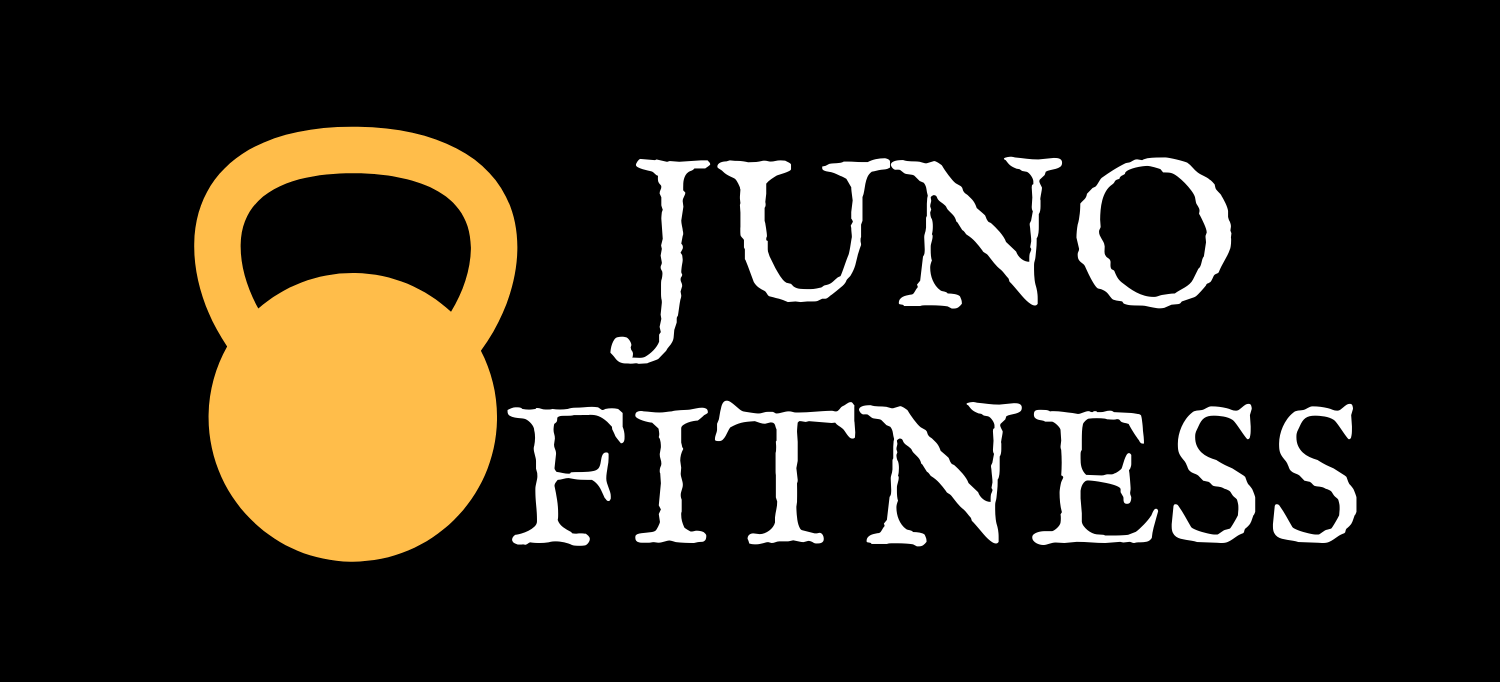
 PRESSES
PRESSES